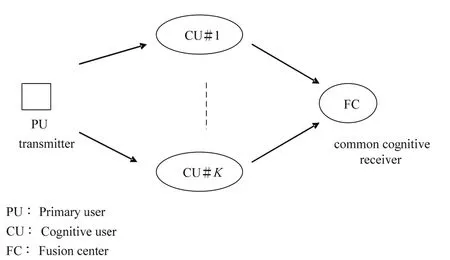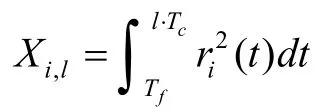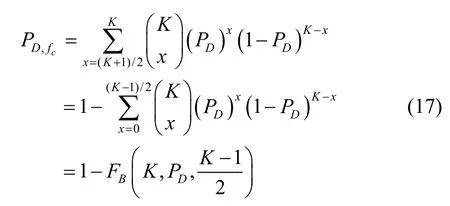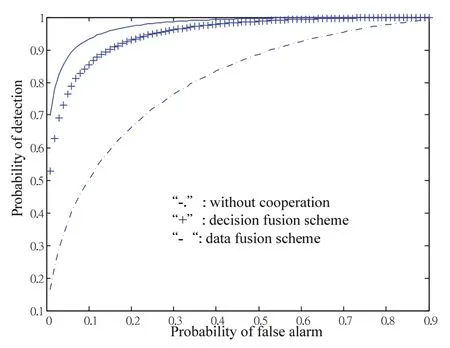Energy-Based Collaborative Spectrum Sensing for Cognitive UWB Impulse Radio
2015-11-18WeiChiangWuandChunTeWu
Wei-Chiang Wu and Chun-Te Wu
Energy-Based Collaborative Spectrum Sensing for Cognitive UWB Impulse Radio
Wei-Chiang Wu and Chun-Te Wu
—This paper focuses on the issue of collaborative spectrum sensing in cognitive ultra wideband (CUWB) impulse radio. We employ energy-based signal detection method and apply the Neyman-Pearson (NP) decision rule to determine the optimum threshold. Two cooperative spectrum sensing schemes are developed in this paper. The decision fusion scheme is based on hard decision, in which each cooperating cognitive user (CU) sends its own local decision to the fusion center (FC). The FC then makes a final decision according to the majority voting rule. Alternatively, the data fusion scheme is based on soft decision, in which each local CU sends its observed value directly to the FC. The FC combines these values,compares to a threshold and then makes the final decision. The performances of both schemes are studied by using analytical tools and computer simulations. The receiver operating characteristics (ROC), which reveal the probability of detection versus false-alarm curve, are employed to evaluate the system performance under different scenarios. Simulation results demonstrate that the data fusion scheme outperforms the decision fusion scheme and verify that the collaborative spectrum sensing has practical importance in CUWB networks.
Index Terms—Cognitive ultra wideband impulse radio, collaborative spectrum sensing, decision fusion,receiver operating characteristics, Neyman-Pearson decision rule.
1. Introduction
Cognitive radio (CR) has recently shown its potential for next-generation wireless communications for efficient utilization of the radio spectrum[1]-[6]. The growing interest towards cognitive radio stems from its promising features to overcome the spectrum congestion. In CR systems, the secondary (cognitive) users (CUs) can use the licensed spectrum as long as the primary user (PU) is absent at some particular time slots or some specific geographic area. When a CU is using a spectral band and a PU is turned on,the CU must detect the PU’s signal and release the channel immediately in order not to interfere PU’s transmission. In general, the primary objective of CR network is real time spectrum sensing or awareness in order that the radio spectrum can be efficiently utilized.
Ultra wideband (UWB) impulse radio (IR) system has spurred great attention for the promised applications in high-speed short-range indoor wireless communication systems. The attractive features of UWB IR technology include low-power, low-complexity, carrierless modulation,and ample multipath diversity[4],[7]-[11]. Due to the ultra wide bandwidth of UWB signal, it will unavoidably overlap with the existing and planned (future) radio systems. Therefore,the coexistence and compatibility in cognitive UWB(CUWB) IR is a key issue needing to be solved[4]for future wireless communications.
Spectrum sensing, which is one of the most important challenges in CR communications, is inherently a binary hypothesis testing problem[12]. For common practice, we denote the “noise only hypothesis (PU is absent)” as H0and“PU signal present hypothesis” as H1. The main design goals for spectrum sensing are higher probability of detection (PD) and lower probability of false-alarm (PF). In[13], a matched-filter (MF) detection based spectrum sensing scheme was developed. As it is well-known, the MF is equivalent to correlating the incoming signal to a known template signal (PU’s signal waveform). Due to coherent detection, the MF’s output signal-to-noise power ratio (SNR) is maximized provided that PU is in operation. Whereas, there are two major disadvantages: 1) The coherent receiver is more complex due to extra timingrecovery circuit. Moreover, it would require a dedicated MF for each PU with different signal waveform. 2)Unfortunately, the PU signal type is generally unknown to the CU which would lead to the MF based spectrum sensing scheme physically unrealizable. The work of [14]proposed a frequency domain test in spectrum sensing,however, it is not appropriate for the detection of UWB IR signal since the bandwidth is extremely large. If the prior knowledge of the PU signal is unknown to the CU, an energy detection based spectrum sensing scheme is usually applied[15]. Reference [16] presented an energy detection based ultra-wideband noncoherent receiver.
A great challenge of implementing spectrum sensing is the hidden terminal problem, which occurs when the CU is shadowed. Exploiting the spatial diversity, the collaborative(cooperative) spectrum sensing provides significant gains to enhance the reliability of PU detection[3],[17]. The performances of collaborative spectrum sensing and spectrum sharing under imperfect sensing have also been investigated recently[18],[19]. The basic idea behind collaborative spectrum sensing rests on the observation that,in a wireless environment, the signal transmitted by PU is first broadcast to a number of cooperating CUs, which is also referred to as relays in wireless sensor networks. The cooperating CUs process (or forward directly) and retransmits the received signal to a common cognitive receiver, which is referred to as fusion center (FC). The FC then makes decision of whether PU is present based on the data coming from the cooperating CUs. Benefited from the spatial diversity of the same signal at various CUs, the PU can be detected with much higher probability at the FC.
In this paper, we propose energy-based collaborative spectrum sensing techniques for CUWB IR networks. The received signal at each CU is first squared and then integrated over an observation interval (a frame duration). Two cooperative spectrum sensing schemes are developed: decision fusion and data fusion. In the decision fusion scheme, the output of the integrator at each CU is compared to a predetermined threshold to determine whether the PU is present. These local decision results are reported to an FC to make a final decision according to the majority voting rule. While in the data fusion scheme, the local decision at each CU is no longer needed, each CU just sends the integrator output to an FC. Based on the multiple observation values from the cooperating CUs, the FC forms a decision statistic, compares to a threshold, and gives a final decision. Since the a priori probabilities for H0and H1are hard to acquire, we determine the optimum threshold by exploiting the Neyman-Pearson (NP) decision rule[12]. The performances of both schemes are extensively analyzed and evaluated numerically.
The remainder of this paper is organized as follows. In Section 2, we introduce the signal model of the UWB impulse radio and generalize the spectrum sensing as a binary hypothesis testing problem. Section 3 describes the energy-based spectrum sensing algorithm. The performance at the local CU is derived by the NP decision rule. The data fusion and decision fusion cooperative spectrum sensing algorithms are analyzed in Section 4. Section 5 presents the simulation results and interpretations. Concluding remarks are finally made in Section 6.
2. Signal Model
We assume that PU is a binary BPSK (binary phaseshift keying) modulated UWB signal, in which the binary data are carried in the polarity of the pulse. A BPSK UWB signal can be modeled as




Fig. 1. Considered collaborative spectrum sensing structure in a CUWB network.
3. Energy-Based Signal Detection
3.1 Algorithm Description
To simplify the CU’s receiver design, an energy detector is employed at each CU. The energy detection isperformed by collecting the received signal energy within the observation interval of one frame, Tf. The decision statistic at the ith CU can be obtained as



Under H0, we have. Since Tc. is with ultrashort duration,can be regarded as Ncstatistically independent Gaussian random variables with zero mean and variance σ2. Therefore, (4) is with the following distribution [20, chap. 2]


where the Gamma function can be evaluated as. If the PU is in operation,are assumed to be statistically independent Gaussian random variables with meanand identical variances equal to σ2. Considering the signal model of (1), since there is only one pulse in each frame, all the values ofare zero except one of, which is A2. Therefore, after some manipulations, we can obtained from [20, chap. 2] thatis a noncentral chi-square random variable with Ncdegrees of freedom. The PDF ofyields

where Iα(x) is the αth order modified Bessel function of the first kind[21], which may be represented by the infinite series:

3.2 Neyman-Pearson (NP) Decision Rule
In the detection problem, we aim at appropriately separating the observation space into two regions, R0and R1. If, decide H0, otherwise, decide H1. Therefore, the false-alarm probability, PF, the probability of detection, PD,the probability of miss, PM, are defined, respectively, as

The goal of spectrum sensing is twofold: i) Maximize PD(or equivalently, minimize PM) such that the interference of PU resulted from CU is minimized. ii) Minimize PFsuch that the spectrum utilization efficiency is maximized. However, these two goals are generally conflict, which means, it is not possible to maximize PDand minimize PFat the same time. The rationale of NP decision rule[12]first sets a criterion thatFP α≤ based on the constraint to maximize PD. Therefore, appropriate (optimum) threshold η needs to be determined to separate the observation space. In what follows, we may rewrite the false alarm probability of (9) as


In NP decision rule, to maximize the spectrum utilization efficiency, it is required that the false-alarm probability is less than α. Substituting (11) into (10), we may determine the threshold η by solving

As long as η is obtained, PDcan be calculated accordingly:


where the generalized Marcum’s Q function is defined as

Therefore, given η, PDcan be obtained by substituting (14)into (13), which yields

4. Collaborative Spectrum Sensing Schemes
Two collaborative spectrum sensing schemes are considered in this paper: decision fusion and data fusion[17]. In the decision fusion scheme, every CU performs its own local spectrum sensing independently, makes a binary decision on H0or H1, and forward their decisions (“1”denotes H1and “0” denotes H0) to a common cognitive receiver, which is referred to as an FC. Alternatively, in the data fusion scheme, each CU just sends the observed value,directly to the FC. And the FC makes final decision of “whether the PU is present” based on the collected multiple observations.
4.1 Decision Fusion Scheme
We assume that the number of cooperating CUs, K, is odd. The FC exploits majority voting rule, in which the FC decides “PU is present” if and only if there are at least( 1)/2K+ local CUs sending “1” to the FC. Therefore, the detection probability at the FC can be obtained as:

where PDdenotes the probability of detection at local CU, which is given byis defined as the CDF of the binomial random variable with parameters K, P,and N, and is given by

Similarly, the overall false alarm probability at FC for the decision fusion scheme can be obtained as:

In NP decision rule, we need to set a constraint on the false alarm probability at the FC as,cFfP α≤ . Therefore, the required PFat each CU can be obtained by solving the inequality:

Solving the bound of PFand substituting into (10), we get the optimum threshold at each CU. In what follows, the detection probabilities at each CU and the FC can be obtained according to (16) and (17), respectively.
4.2 Data Fusion Scheme
Instead of transmitting the binary decision, each CU may send the observed value or decision statistic to the FC. In the proposed data fusion scheme, the FC forms new decision statistic by summing the observed value received from each CU, which yields

Under H0, sinceis i.i.d. central chi-square distribution with Ncdegrees of freedom. Under H0, the decision statistic, Z, is still central chi-square distribution with KNcdegrees of freedom,The PDF of Z under H0can be deduced as

Similarly, if PU is in operation,is i.i.d. noncentral chi-square random variable with Ncdegrees of freedom. We can deduce that the PDF of Z under H1is

By setting an appropriate threshold,cfη , at the FC, the false alarm probability can be calculated as


In NP decision rule, to maximize the spectrum utilization efficiency, it is required that the false-alarm probability is less than α. Substituting (25) into (24), we may determine the thresholdcfη by solving

As long ascfη is obtained, the probability of detection can be calculated as well:


where the generalized Marcum’s Q function is defined as(15). Therefore, givencfη , probability of detection at the FC can be obtained by substituting (28) into (27), which yields

5. Performance Evaluation
In this section, various scenarios are employed to evaluate the performance of the proposed collaborate spectrum sensing algorithms. Note that the parameter of SNR in the UWB IR system is defined as[22]

wherepE denotes the single pulse energy.2σ is the noise power.fT denotes the frame duration. Substitutingand, which is considered in the signal model of (1), into (30) yields

Unless otherwise mentioned, the parameters’ setting of the duty ratio isand the SNR of the PU is -5 dB.
A plausible criterion to measure the spectrum awareness and spectrum efficiency is the PDversus PFcurve, which is referred to as receiver operating characteristics (ROC). Fig. 2 presents the ROC for both the data and decision fusion schemes, where the number of cooperative CUs is 5. The case without cooperation (K=1)is also provided for comparison. As shown in Fig. 2, for a specific PF, the collaborative spectrum sensing schemes essentially enhance the PDof the case without cooperation. Moreover, it is also verified that the data fusion outperforms the decision fusion scheme. Indeed, the data fusion and decision fusion in CR networks have an analogy to the soft decision and hard decision, respectively, in communication systems.
In the second simulation example, we attempt to investigate the performance improvement in accordance with the number of cooperating CUs. We consider the decision fusion scheme, though the case for data fusion can be evaluated in a similar way. Fig. 3 presents the ROC of the decision fusion scheme, where we perform the simulation for K=1 (without cooperation), 5, 9, and 13. As shown in Fig. 3, the performance improves as we increase K. This verifies the performance improvement of the diversity algorithm. It is due to the fact that the spatial diversity technique is able to mitigate fading in wireless communication systems.

Fig. 2. Performance of PDwith respect to PFwith SNR=-5 dB,Nc=40 and K=5.

Fig. 3. Performance of PDwith respect to PFfor the decision fusion scheme with SNR= -5 dB and Nc=40.
In the final simulation example, we aim at demonstrating the sensitivity of the proposed energy-based spectrum sensing algorithm with respect to the SNR of PU. We evaluate PDversus the SNR of PU (ranging from -10 dB to 2 dB), where both the collaborative schemes and the case without cooperation are provided for comparison. As expected, PDincreases rapidly in accordance with SNR, as shown in Fig. 4. This verifies that all the three schemes that are based on energy detection are very sensitive to the SNR of PU. It is also observed in the simulation result, PU can be detected even in very low SNR.

Fig. 4. Performance of PDwith respect to SNR with K=5 and Nc=40.
6. Conclusions
In this paper, we studied the issue of collaborative spectrum sensing in the CUWB impulse radio. We applied the energy-based PU signal detection method in each cooperating CU. Decision fusion and data fusion methods were employed in the FC in order to determine whether PU was in operation. Through the analytical and simulation results, we have demonstrated that by employing the diversity combining, the probability of detection is extensively enhanced. As it is well-known, the UWB signal has low power characteristics, nevertheless, we have verified that PU signal can be detected in a very low SNR scenario. Moreover, we have shown that the data fusion scheme is essentially better than the decision fusion scheme. Though BPSK modulated UWB signal was considered for the analysis in this paper, other modulation schemes, e.g.,PPM, PAM, or M-ary signal format can be applied without conceptual difficulty since the proposed decision statistic is the energy rather than the pulse format within a frame. Consequently, we can conclude that due to the above benefits, it is plausible to apply the proposed energy-based collaborative spectrum sensing schemes in CUWB networks.
[1] S. Haykin, “Cognitive radio: Brain-empowered wireless communications,” IEEE Journal Selected Areas on Communications, vol. 23, no. 2, pp. 201-220, 2005.
[2] S. Ghavami and B. Abolhassani, “Spectrum sensing and power/rate control in CDMA cognitive radio networks,” Int. Journal of Communication Systems, vol. 25, no. 2, pp. 121-145, 2012.
[3] G. Ganesan and Y. Li, “Cooperative spectrum sensing in cognitive radio networks,” IEEE Trans. on Wireless Communications, vol. 6, pp. 2204-2222, Jun. 2007.
[4] F. Granelli and H. Zhang, “Cognitive ultra wide band radio: A research vision and its open challenges,” in Proc. of the 2nd Int. Workshop on Networking with UWB, Rome, 2005,pp. 55-59.
[5] H. Shatila, M. Khedr, and J. H. Reed, “Opportunistic channel allocation decision making in cognitive radio communications,” Int. Journal of Communication Systems,vol. 27, no. 2, pp. 216-232, 2014.
[6] J. Zhang, Z. Zhang, H. Luo, W. Wang, and G. Yu, “Initial spectrum access control with QoS protection for active users in cognitive wireless networks,” Int. Journal of Communication Systems, vol. 25, no. 5, pp. 636-651, 2012.
[7] M. Z. Win and R. A. Scholtz, “Ultra wide bandwidth time-hopping spread-spectrum impulse radio for wireless multiple access communications,” IEEE Trans. on Communications, vol. 48, no. 4, pp. 679-691, 2000.
[8] M. Z. Win, R. A. Scholtz, and M. A. Barnes, “Ultra-wide bandwidth signal propagation for indoor wireless multiple access communications,” in Proc. of IEEE Int. Conf. Communications, Montreal, 1997, pp.56-60.
[9] M. Z. Win and R. A. Scholtz, “On the robustness of ultra-wide bandwidth signals in dense multipath environments,” IEEE Communications Letters, vol. 2, no. 2,pp. 51-53, 1998.
[10] W. C. Wu, “Blind signal reception in downlink time-hopping ultrawideband communication system,” European Trans. on Telecommunications, vol. 19, no. 1, pp. 77-84, 2008.
[11] M. Z. Win and R. A. Scholtz, “Impulse radio: How it works,” IEEE Communications Letters, vol. 2, no. 2, pp. 36-39, 1998.
[12] S. M. Kay, Fundamentals of Statistical Signal Processing: Detection Theory, Upper Saddle River: Prentice Hall, 2001.[13] D. Cabric, S. M. Mishra, and R. W. Brodersen,“Implementation issues in spectrum sensing for cognitive radios,” in Proc. of Asilomar Conf. Signals, System, Comput.,2004, pp. 772-776.
[14] T. Agrawal, V. Lakkundi, A. Griffin, et al., “Compressed sensing for OFDM UWB systems,” in Proc. of the IEEE Radio and Wireless Symposium, Phoenix, 2011, pp. 190-193.
[15] A. Sahai, N. Hoven, and R. Tandra, “Some fundamental limits on cognitive radio,” presented at Allerton Conf., 2004.
[16] S.-Y. Jung, “Design of a preamble signal for synchronization in ultra-wideband noncoherent energy detection receivers,”Int. Journal of Communication Systems, vol. 26, no. 4, pp. 465-480, 2013.
[17] K. B. Letaief and W. Zhang, “Cooperative communications for cognitive radio networks,” Proc. of the IEEE, vol. 97, no. 5, pp. 878-893, 2009.
[18] S. Tang, “A general model of opportunistic spectrum sharing with unreliable sensing,” Int. Journal of Communication Systems, vol. 27, no. 1, pp. 31-44, 2014.
[19] S. Chaudhari, J. Lunden, and V. Koivunen, “BEP walls for collaborative spectrum sensing,” in Proc. of 2011 Int. Conf. on Acoustic, Speech and Signal Processing, Prague, 2011,pp. 2984-2987.
[20] J. G. Proakis, Digital Communications, 4th ed. New York: McGraw-Hill, 2001.
[21] Erwin Kreyszig, Adνanced Engineering Mathematics, 8th ed. Hoboken: John Wiley & Sons Inc. 1999.
[22] X.-O. Song, X. Xiang, D.-Y. Bi, and Y. Deng, “Pulse signal detection in cognitive UWB system,” The Journal of China Uniνersities of Posts and Telecommunications, vol. 19, no. 3,74-79, 2012.

Wei-Chiang Wu was born in Miaoli in 1964. He received the B.S. degree in electrical engineering from the Chung Cheng Institute of Technology, Taoyuan in 1986, and the M.S. and Ph.D. degrees both in electrical engineering from the National Tsing Hua University, Hsinchu in 1992 and 1998,respectively. From 1992 to 1994, he was an assistant researcher with the Communication Department, Chung Shan Institute of Science and Technology, Taibei. From 1998 to 2000, he was in the Army, where he conducted the research of integrated logistic support (ILS). Since 2011, he has been a professor with the Department of Electrical Engineering, Da-Yeh University, Changhua. His current research interests are in multiuser detection, smart antenna technology, cognitive radio,and ultra-wideband (UWB) impulse radio (IR) technology.

Chun-Te Wu was born in Tainan in 1968. He received the B.S. degree in electrical engineering from the Chung Yuan Christian University, Taoyuan in 1990, and the M.S. and Ph.D. degrees both in electrical engineering from the National Taiwan University, Taipei in 1995 and 2002,respectively. He is an assistant professor With Da-Yeh University, Changhua. His areas of interest include computational electromagnetics, thin-slot formalism for finite difference time domain analysis, and the issues of signal integrity.
Manuscript received November 17, 2014; revised January 6, 2015.
W.-C. Wu is with the Department of Electrical Engineering, Da-Yeh University, Changhua 515 (Corresponding author e-mail: wcwm53@mail. dyu.edu.tw).
C.-T. Wu is with the Department of Electrical Engineering, Da-Yeh University, Changhua 515 (e-mail: samuel@mail.dyu.edu.tw).
Digital Object Identifier: 10.3969/j.issn.1674-862X.2015.02.016
杂志排行
Journal of Electronic Science and Technology的其它文章
- Modeling of a Planar Nine-Way Metamaterial Power Divider/Combiner
- Simplified 3D Fading Channels Adopted in MIMO Beamforming Schemes
- Novel Sequence Number Based Secure Authentication Scheme for Wireless LANs
- Robust Stability of a Class of Fractional Order Hopfield Neural Networks
- Monitoring of PON System Using Compound Surveillance Technique
- QCM Sensors Based on PEI Films for CO2Detection
